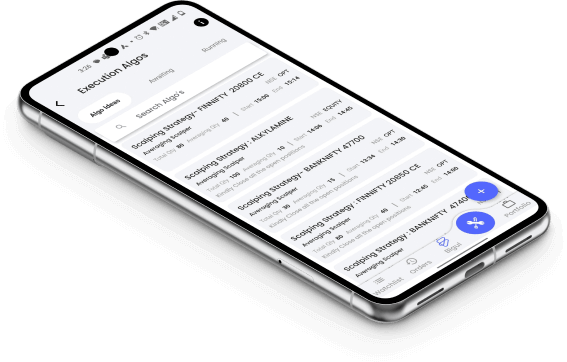Open an Account & Start Algo Trading Today!
- Flat Rs 18 brokerage
- No Cost Algo Trading
- Trade from Chart
- 30+ Indicators
- Stock SIP
- Smart Case
- Bigul Option Chain
- 300+ Pre Defined Market Watch
- IPOs
- Basket Order
Collar Options Trading Strategy
Collar options, a savvy financial strategy, combine the security of stock ownership with the protection of options trading.
Basically, a collar involves holding a long stock position while simultaneously purchasing a put option for downside protection and selling a call option to offset costs. This dynamic approach serves a dual purpose: safeguarding against potential losses and generating income.
Investors utilize collar options to navigate market volatility, providing a strategic balance between risk and reward. Let's delve into the fundamentals of collar options, exploring their definition, trading strategy, and the invaluable role they play in shaping a resilient investment portfolio.
What is the Collar Options Strategy?
The Collar Options Strategy is a smart way to protect your investments in the stock market. Imagine you own stocks, and you want to safeguard them from potential drops in value.
A collar lets you do this by combining different financial moves. You buy a "put" option to limit losses if the stock goes down, and you sell a "call" option to offset some of the costs.
This strategy provides a safety net for your stocks while also creating opportunities for income. Essentially, it's a method to navigate the ups and downs of the market, ensuring a more secure and balanced investment approach.

How does a Collar Options Strategy work?
A Collar Options Strategy involves combining three key elements: a long stock position, a long put option, and a short call option. This strategy is primarily used to protect an existing stock investment against potential downside risks while generating income from the options market. Here's how a Collar Options Strategy works:
1. Long Stock Position
The investor starts with an existing long stock position, reflecting their bullish outlook on the stock.
2. Long Put Option
To protect against potential price declines, the investor simultaneously purchases a put option. This put option acts as an insurance policy, allowing the investor to sell the stock at a predetermined price (strike price) regardless of how much the stock's market price falls. This limits the potential losses in case of a decline in the stock's value.
3. Short Call Option
To offset the cost of buying the put option, the investor sells a call option. This obligates them to sell the stock at a specified price (strike price) if the stock's market price rises above that level. While this caps the potential gains from the stock's appreciation, it helps finance the purchase of the put option.
How to Implement a Collar Options Trade
Implementing a collar options trade involves a systematic approach to ensure effective risk management and potential profit. Here's a step-by-step guide to executing a collar options strategy:
1. Selecting an Underlying Asset
Choosing the right stock or asset is crucial when implementing a collar options trade. Look for an asset in your portfolio that you want to protect against potential losses.
Consider its recent performance, how volatile it is, and whether it aligns with your overall investment goals.
By selecting a suitable underlying asset, you lay the foundation for a collar strategy that balances risk and reward, providing a solid starting point for effective options trading.
2. Choosing Strike Prices
Selecting the right strike prices is crucial in a collar options trade. The put option's strike should be below the current stock price for effective downside protection. Simultaneously, the call option's strike should be above the stock price to generate income.
Balancing these strike prices ensures the collar strategy effectively shields against potential losses while still allowing for profit potential through the call option.
3. Determining Position Sizes
Decide how many shares of the underlying stock to collar. Ensure the number of shares aligns with the contract sizes of the options—put for downside protection and call for income.
Balancing these quantities is crucial for creating a harmonized collar options trade that maximizes protection and potential returns while aligning with your overall investment strategy.
4. Executing the Trade
Once you've selected the stock and determined strike prices, execute the collar options trade by buying a put option for protection and selling a call option for income. This can be done through your brokerage platform by placing orders for both options.
Ensure the quantities align with your stock position, and confirm the execution to establish a well-rounded collar strategy for managing risk and potential returns in the market.
5. Monitoring and Adjusting Positions
After implementing a collar options trade, vigilance is key. Regularly observe the stock's performance and market conditions. If the stock price fluctuates, be prepared to make strategic adjustments.
This may involve rolling options contracts forward, closing positions, or applying additional tactics to maximize gains and protect against potential losses.
Staying actively engaged ensures that your collar strategy remains aligned with your financial goals in the ever-changing landscape of the stock market.
Risks of Collar Options Trading
Collar options trading, while offering various advantages, comes with its share of risks that investors need to carefully consider. It is important to understand these risks in order to make smart choices and deal with possible problems. Here are some key risks associated with collar options trading:
1. Limited Profit Potential
One of the primary risks of collar options trading is the capped profit potential. While the strategy provides downside protection, it also limits the upside potential of the underlying stock. If the stock experiences significant gains, your profit is restricted to the agreed-upon call strike price.
2. Cost of Implementation
Establishing a collar position involves purchasing a put option for protection, and this incurs an upfront cost. The expense of buying the put can reduce the overall profitability of the trade, especially if the stock price doesn't decline significantly.
3. Opportunity Cost
Collar options may restrict an investor's ability to benefit from a strong upward market trend. If the stock price surges, the gains are offset by the short call position, potentially resulting in missed profit opportunities.
4. Market Conditions and Volatility
Collar options may be less effective in highly volatile markets. Sharp price movements can trigger adjustments, and the costs associated with frequent modifications may erode potential profits.
Advantages of Collar Options Trading
Collar options trading offers a range of advantages that make it an appealing strategy for investors looking to manage risk and enhance their overall portfolio. Here are key advantages of collar options trading:
1. Downside Protection
Collar options allow you to generate income by selling a call option against the long stock position. While this caps the potential upside, it provides a steady stream of premium income. This income can be particularly valuable in sideways or slightly bullish markets.
2. Income Generation
Collar options allow you to generate income by selling a call option against the long stock position. While this caps the potential upside, it provides a steady stream of premium income. This income can be particularly valuable in sideways or slightly bullish markets.
3. Mitigation of Market Volatility
In volatile markets, collar options can act as a stabilizing force. The combination of protective puts and covered calls helps you navigate unpredictable price swings. This can be especially valuable for risk-averse investors seeking a balanced approach to market exposure.
4. Flexibility in Portfolio Management
Collar options provide flexibility in managing a portfolio. You can adjust the strike prices of the options or change the expiration dates to adapt to evolving market conditions. This adaptability is crucial for optimizing the strategy based on your outlook and market trends.
5. Cost-Effective Hedging
Collar options provide a cost-effective way to hedge against potential losses in a stock position. Compared to purchasing standalone put options, the collar strategy allows you to offset some of the hedging costs by selling call options, making it a more economical risk management tool.
Tips for Successful Collar Options Trading
Trading collar options is very complicated, so you need to be careful and follow a plan. Here are a few but most crucial tips to increase your chances of success:
1. Stay Informed About Market Trends
Keep a close eye on market trends and key economic events to inform your collar options trading. Stay updated on factors influencing the underlying asset, like earnings reports and industry shifts.
Being aware of market conditions allows you to make timely decisions, adapting your strategy to changes and maximizing the effectiveness of your collar positions.
Regular monitoring ensures you remain well-informed and better equipped to navigate the dynamic landscape of options trading.
2. Regularly Review and Adjust Positions
Regularly reviewing and adjusting your collar options positions is crucial for success. Keep an eye your investments periodically to ensure they align with your goals. If market conditions or your overall strategy change, consider tweaking the strike prices and expiration dates accordingly.
This proactive approach allows you to adapt to evolving circumstances, optimizing your collar options for the best risk-reward balance and ensuring your investment strategy stays on track.
3. Diversify Collar Positions Across Different Assets
Diversifying collar options across different assets means spreading your investment risk. Instead of putting all your money in one type of asset, like stocks from a single industry, consider investing in a variety of assets. This way, if one sector faces challenges, the impact on your overall investment is reduced.
Diversification helps balance your portfolio and protects against potential losses, contributing to a more resilient and stable investment strategy.
4. Understand the Cost of Implementation
Understand the costs of collar options trading. Consider fees and expenses associated with initiating and maintaining positions. Be aware of transaction costs, bid-ask spreads, and any additional fees, as these factors impact overall performance.
Evaluating and managing costs helps ensure that potential returns align with your investment goals, enhancing the overall effectiveness of your collar options strategy.
5. Set Realistic Expectations for Returns
Set realistic expectations for collar options trading. Recognize that collars are a conservative strategy focused on preserving capital and protecting against losses, rather than rapid profit generation.
Understand that the primary goal is to mitigate risk, and while income generation is a feature, it may not match the potential returns of more aggressive trading strategies.
6. Monitor Volatility and Adjust Accordingly
Finally, keep a close eye on how much the market changes (volatility) since it affects how well your collar options strategy works. If things get more unpredictable, you might need to make changes to your positions to keep the right balance between risks and rewards.
Adapting to these changes helps your strategy stay effective and protects your investments better.
Conclusion
Collar options offer a smart way to safeguard investments and create income in unpredictable markets. By combining stock ownership with strategic options, investors can find a balance between risk and reward.
Remember, successful trading is about knowledge and the right tools. Consider exploring the user-friendly Bigul Trading platform for a seamless experience in implementing your financial strategies.
Also Read:

Download Bigul Trading App!
Supercharge your trading on the go with the Bigul Trading App! Download now for instant access to cutting-edge features, real-time insights, and unparalleled convenience.













